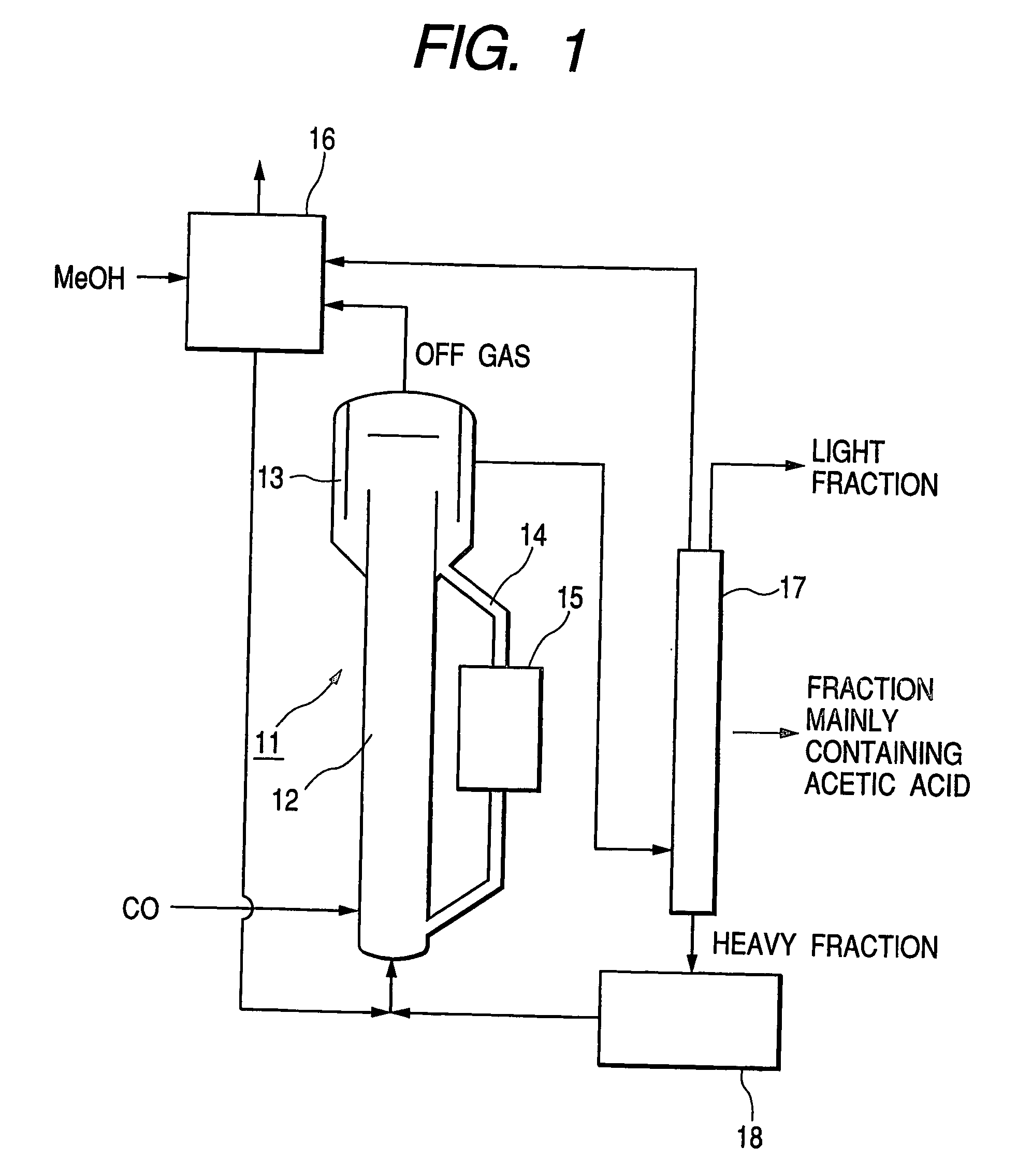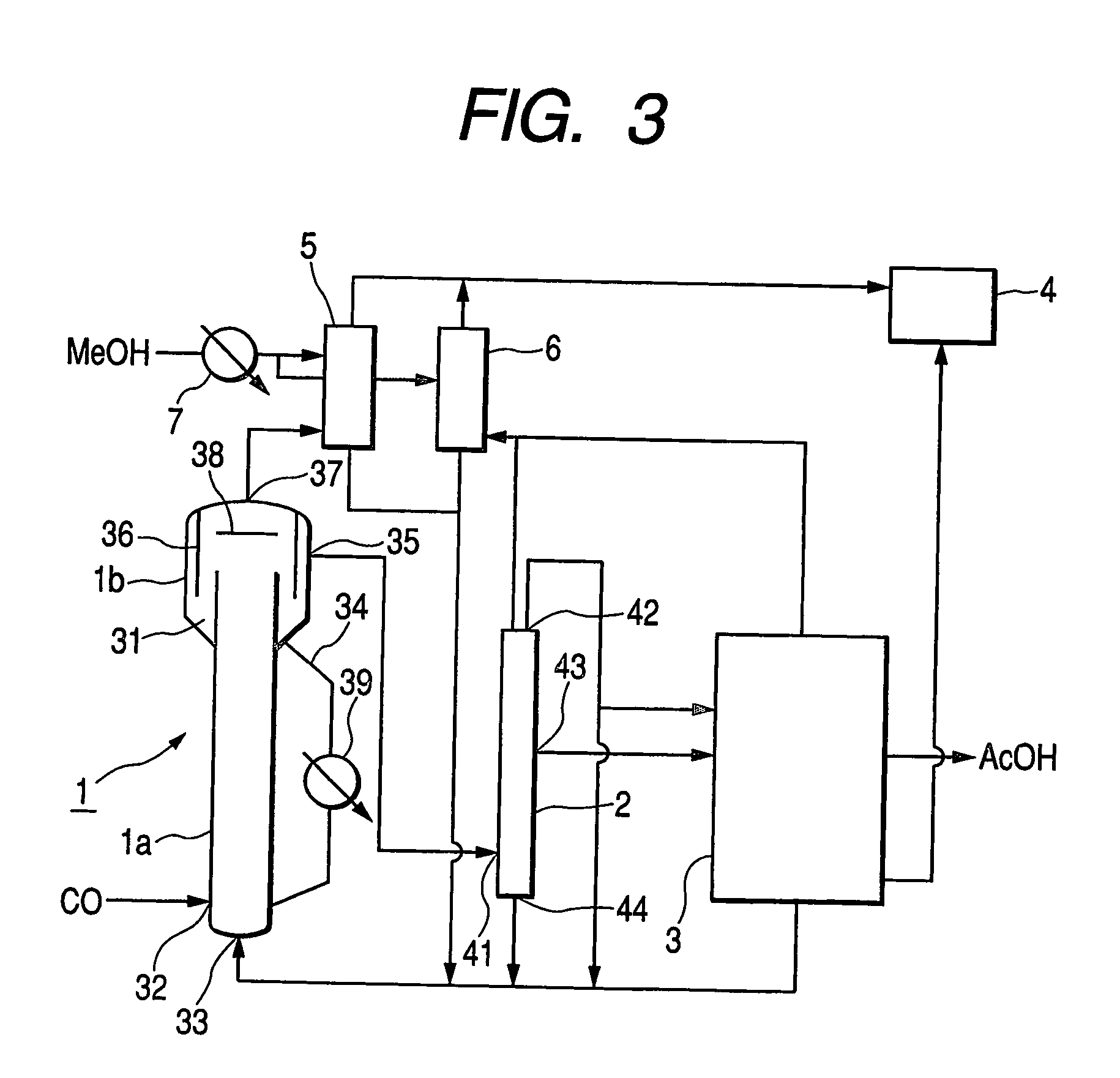Method of manufacturing acetic acid
a technology of acetic acid and manufacturing method, which is applied in the direction of physical/chemical process catalysts, organic compound/hydride/coordination complex catalysts, separation processes, etc., can solve the problem of excessive methanol simply needs to be wasted, significant trouble in operation, and relatively low catalyst concentration, etc. problem, to achieve the effect of promoting side reactions and reducing the productivity of manufacturing acetic acid
- Summary
- Abstract
- Description
- Claims
- Application Information
AI Technical Summary
Benefits of technology
Problems solved by technology
Method used
Image
Examples
example 3
[0075] Acetic acid was manufactured experimentally by using an experimental bubble column reactor with an external circulation system as shown in FIG. 2 (height 6 m, inner diameter of riser section 125 mm, diameter of narrowed section 75 mm). A predetermined amount of catalyst (vinylpyridine type ion exchange resin carrying rhodium complex, specific gravity 1.2, average particle diameter 0.45 mm) was filled into the reactor 21 so as to make the concentration of the solid catalyst per reaction volume to be equal to 135 kg / m3. Then, acetic acid was filled into the riser section 22 by way of liquid lead-in pipe and subsequently carbon monoxide (CO) was injected through the carbon monoxide blow-in ports so as to make it flow upward as jet stream at a predetermined flow rate in order to cause acetic acid and the catalyst to start circulating. At this time, part of the acetic acid that spilled due to the introduced CO was drawn out from the separator section 23 by way of piping. Excessive...
example 4
[0078] Acetic acid was synthetically manufactured by carbonylation of methanol, using the process flow illustrated in FIG. 3. Acetic acid and methyl iodide were put into the reactor 1 respectively by 10 kg and 2 kg and pyridine resin that was turned to be quaternary and rhodium carbonyl complex [Rh(CO)2I2]− were added thereto to prepare a rhodium-containing solid catalyst in the reactor. Subsequently, methanol was introduced through the liquid inlet port 33 by way of the absorption towers 5 and 6 at a rate of 5.3 kg / min, while carbon monoxide was introduced through the gas inlet port 32 at a rate of 4.2 L / min. The liquid reaction composition that flowed out from the reactor 1 was continuously refined in the flash column 2 and the distillation tower 3 to obtain product acetic acid and the circulating fraction that flowed out from the two towers was returned to the liquid inlet port of the reactor 1. Table 2 shows the operating conditions of the reactor 1, the flash column 2 and the d...
PUM
| Property | Measurement | Unit |
|---|---|---|
| concentration | aaaaa | aaaaa |
| partial pressure | aaaaa | aaaaa |
| partial pressure | aaaaa | aaaaa |
Abstract
Description
Claims
Application Information
 Login to View More
Login to View More - R&D
- Intellectual Property
- Life Sciences
- Materials
- Tech Scout
- Unparalleled Data Quality
- Higher Quality Content
- 60% Fewer Hallucinations
Browse by: Latest US Patents, China's latest patents, Technical Efficacy Thesaurus, Application Domain, Technology Topic, Popular Technical Reports.
© 2025 PatSnap. All rights reserved.Legal|Privacy policy|Modern Slavery Act Transparency Statement|Sitemap|About US| Contact US: help@patsnap.com



